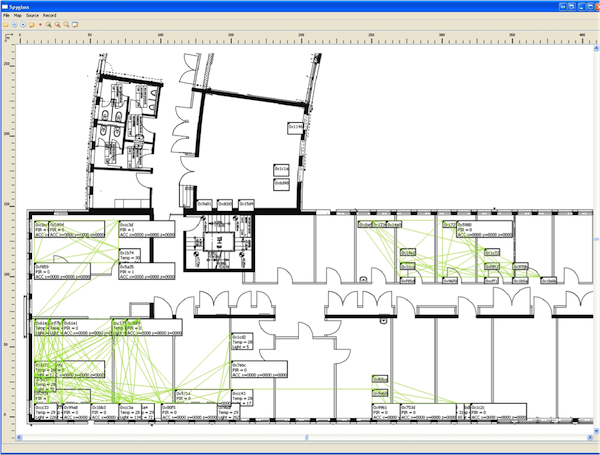-
Notifications
You must be signed in to change notification settings - Fork 0
Home
SpyGlass is an modular and extensible application designed to visualize sensor networks on a screen. It displays a set of sensor nodes at their location on a map, as well as arbitrary data sent by the nodes, e.g. connectivity status between nodes or aggregated data collected by the nodes' sensors.
SpyGlass now supports the WISEBED WSN testbeds! Simply connect to a running experiment from SpyGlass to use it as a packet source for your visualization.

The SpyGlass application itself is a framework, designed to be extendable by plugins that visualize arbitrary things. In fact, all visualization and data aggregation that is done, is done by a set of bundled plugins, each fulfilling a certain functionality. The primary focus of SpyGlass is the visualization of a set of sensor nodes, forming a network. However, SpyGlass can also be used in other, nearly arbitrary scenarios, where packet based communication is used. This is because visualization is done based on network packets, which represent statistical, structural or any other arbitrary data, sent by the nodes to the SpyGlass application. Those packets are then dispatched to the various plugins, which in turn, interpret the packet, draw things onto the screen when appropriate and aggregate data contained in the packets. The whole range of visualization opportunities, delivered by the currently bundled plugins, is described in the SpyGlass github Wiki pages.
SpyGlass bases on the requests given by the Institute of Telematics (ITM) of the University of Lübeck and was developed by Daniel Bimschas, Sebastian Ebers, Dariush Forouher and Oliver Kleine in the context of a case study for professional product development.
- Using SpyGlass
- Packet Format and Packet Types
- StringFormatter
-
Plugins
- NodePainter
- NodePositioner
- RelationPainter
- BackgroundPainter
- GlobalInformation
Please see the Downloads page for binary downloads.
The project is made open-source under the terms of the BSD license, was created and is maintained by the Institute of Telematics, University of Luebeck, Germany.